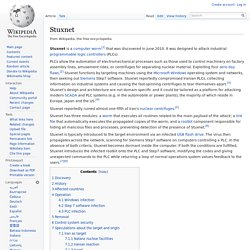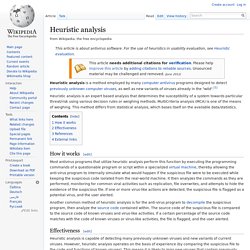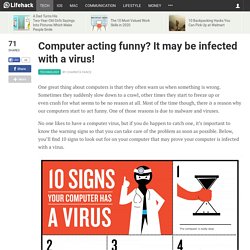

Stuxnet. Stuxnet is a computer worm[1] that was discovered in June 2010.

It was designed to attack industrial programmable logic controllers (PLCs). PLCs allow the automation of electromechanical processes such as those used to control machinery on factory assembly lines, amusement rides, or centrifuges for separating nuclear material. Exploiting four zero-day flaws,[2] Stuxnet functions by targeting machines using the Microsoft Windows operating system and networks, then seeking out Siemens Step7 software. Stuxnet reportedly compromised Iranian PLCs, collecting information on industrial systems and causing the fast-spinning centrifuges to tear themselves apart.[3] Stuxnet’s design and architecture are not domain-specific and it could be tailored as a platform for attacking modern SCADA and PLC systems (e.g. in the automobile or power plants), the majority of which reside in Europe, Japan and the US.[4] Stuxnet reportedly ruined almost one-fifth of Iran's nuclear centrifuges.[5]
Heuristic analysis. This article is about antivirus software.

For the use of heuristics in usability evaluation, see Heuristic evaluation. Heuristic analysis is a method employed by many computer antivirus programs designed to detect previously unknown computer viruses, as well as new variants of viruses already in the "wild".[1] Heuristic analysis is an expert based analysis that determines the susceptibility of a system towards particular threat/risk using various decision rules or weighing methods. MultiCriteria analysis (MCA) is one of the means of weighing. This method differs from statistical analysis, which bases itself on the available data/statistics. How it works[edit] Another common method of heuristic analysis is for the anti-virus program to decompile the suspicious program, then analyze the source code contained within.
Computer acting funny? It may be infected with a virus! One great thing about computers is that they often warn us when something is wrong.

Sometimes they suddenly slow down to a crawl, other times they start to freeze up or even crash for what seems to be no reason at all. Most of the time though, there is a reason why our computers start to act funny. One of those reasons is due to malware and viruses. No one likes to have a computer virus, but if you do happen to catch one, it’s important to know the warning signs so that you can take care of the problem as soon as possible. Below, you’ll find 10 signs to look out for on your computer that may prove your computer is infected with a virus. If you have noticed one or more of the above symptoms on your computer, it’s time to take immediate action. Be sure to share this infographic so that others can benefit as well.
Abby Ryan Design | PC Ninja Featured photo credit: Graphs.net via graphs.net. Zeus (malware) "Zbot" redirects here.

For the action figures, see Zbots. Zeus is very difficult to detect even with up-to-date antivirus software as it hides itself using stealth techniques[citation needed] It is considered that this is the primary reason why the Zeus malware has become the largest botnet on the Internet: some 3.6 million PCs are said to be infected in the U.S. alone[citation needed]. Security experts are advising that businesses continue to offer training to users to teach them to not to click on hostile or suspicious links in emails or Web sites, and to keep antivirus protection up to date. How to remove the Superfish malware: What Lenovo doesn’t tell you.
If you have a Lenovo system that includes the Superfish malware, you'll want to remove it.

Blowing away your system and reinstalling Windows is one way to do this, but while it's a relatively straightforward process, it's a time-consuming one. Using Lenovo's own restore image won't work, because that will probably reinstate Superfish anyway. Performing a clean install from Windows media will work, but you'll have to reinstall all your software and restore all your data from backup to do the job fully. An alternative is to remove the malware itself. Lenovo has published instructions, but at the time of writing, they're woefully inadequate. The Superfish root certificate can be used to create certificates for any domain, and those certificates will be implicitly trusted by the browser on any Superfish-infected system, leaving victims vulnerable to man-in-the-middle attacks.
There are several places that the Superfish certificate can be installed. Lenovo says you should then reboot. Malware Protection Center Home Page.